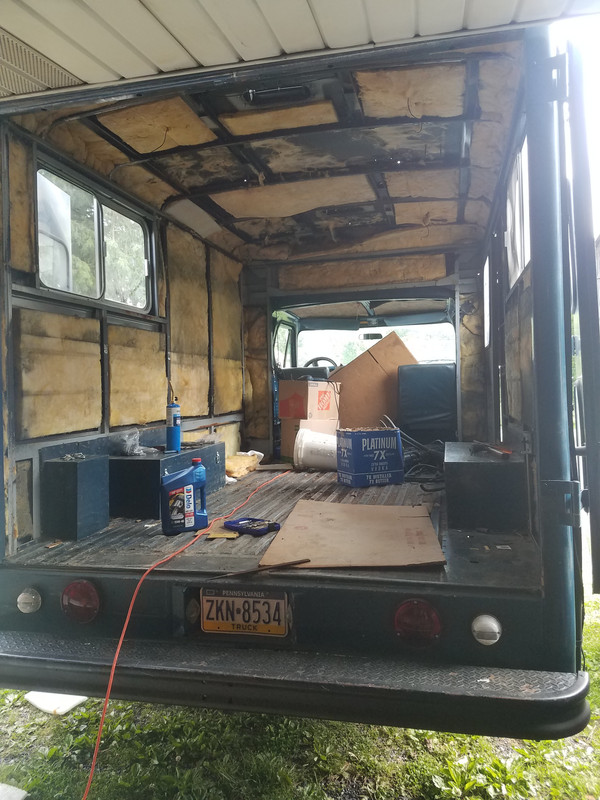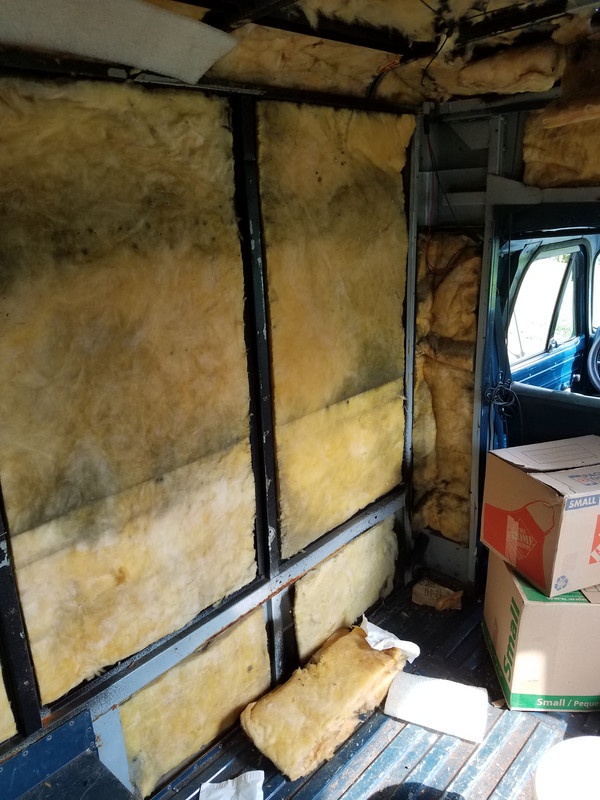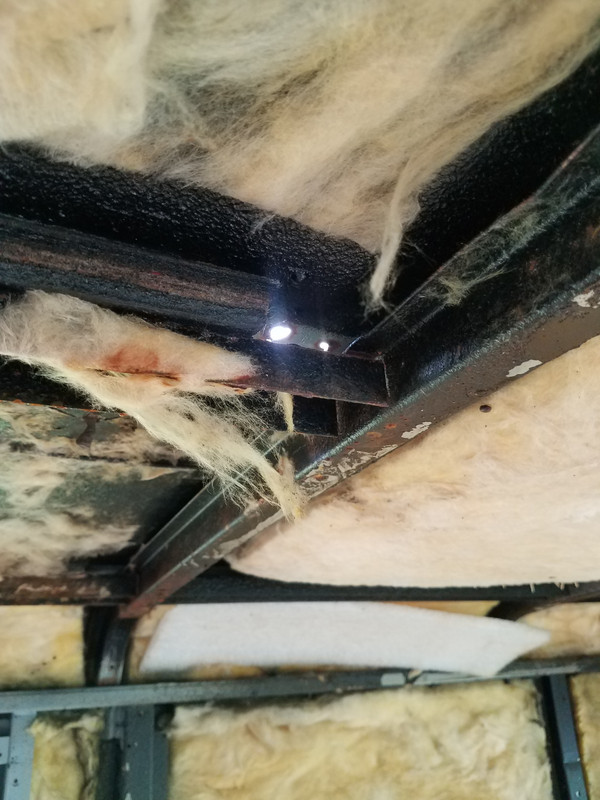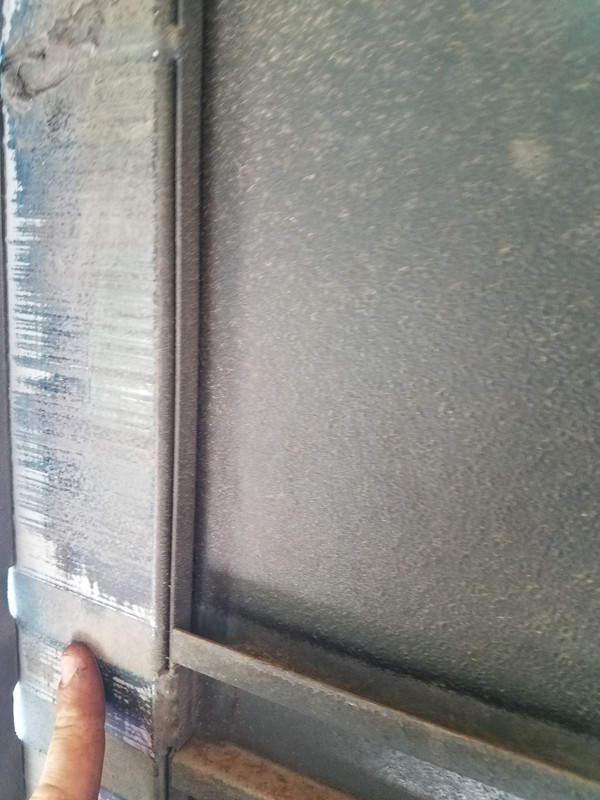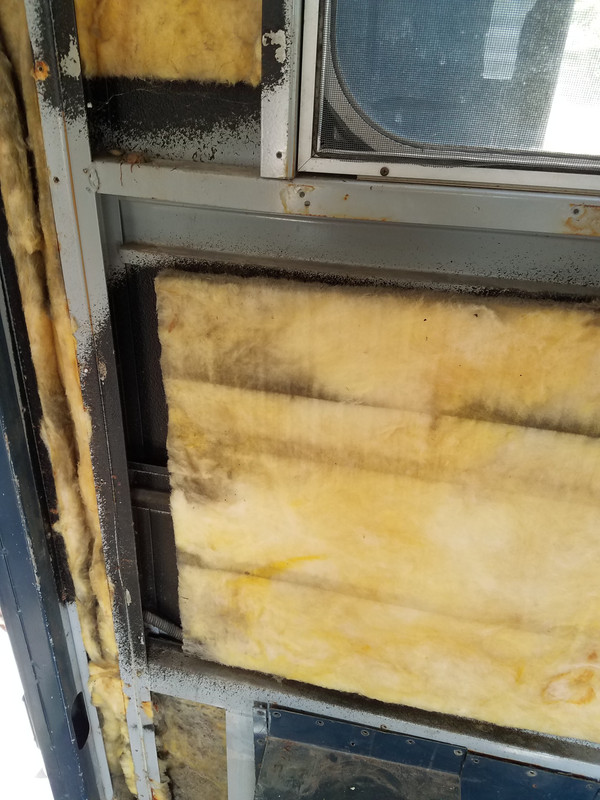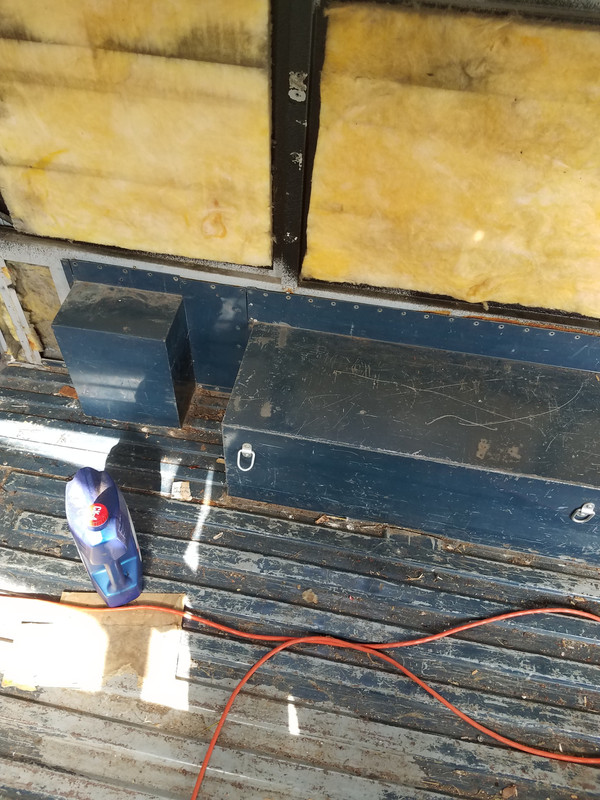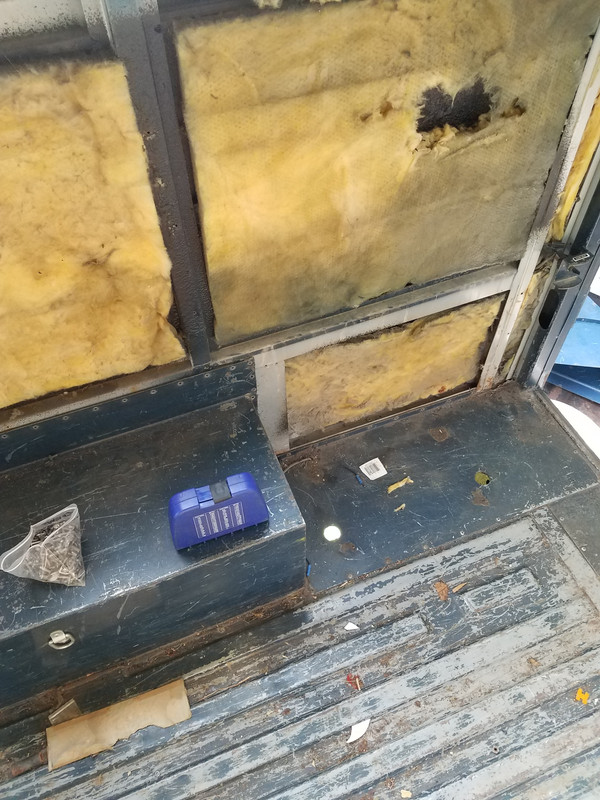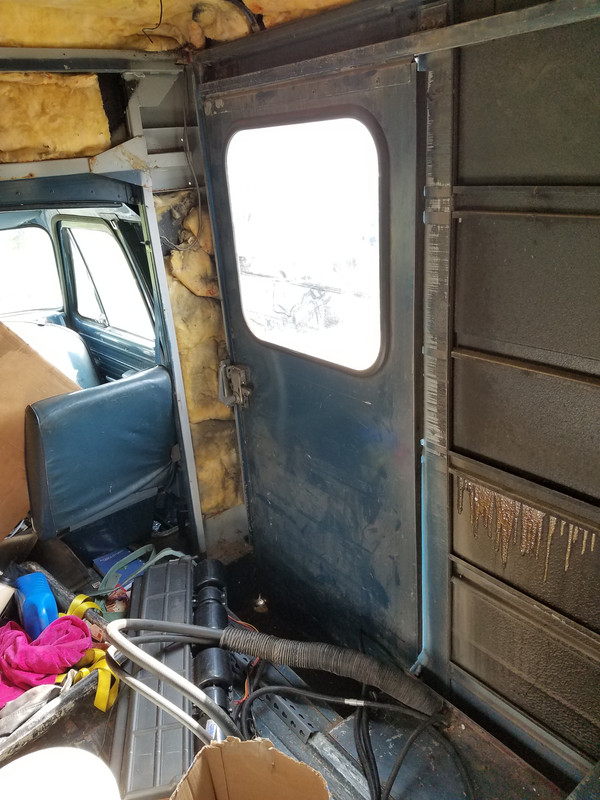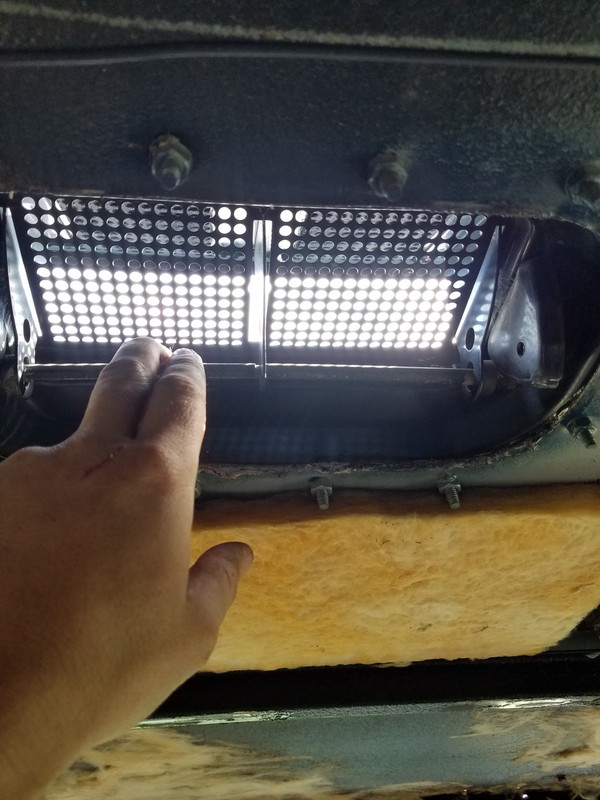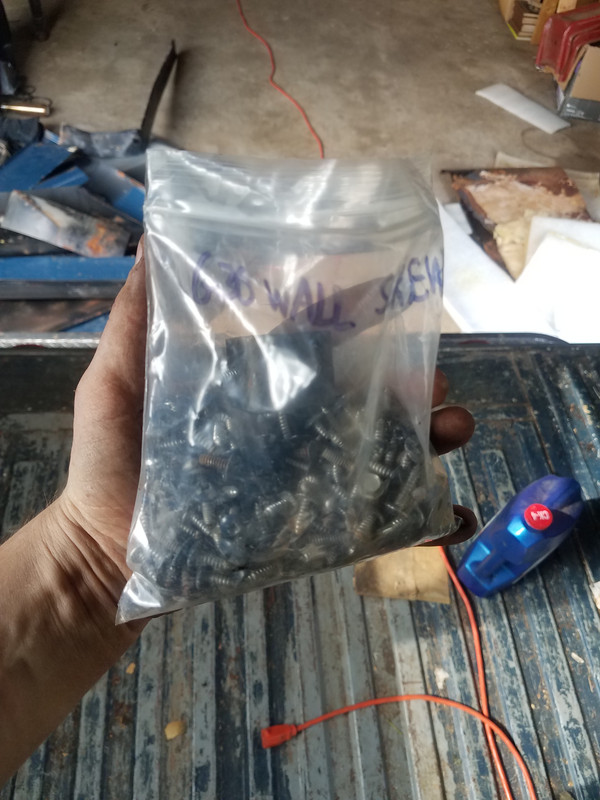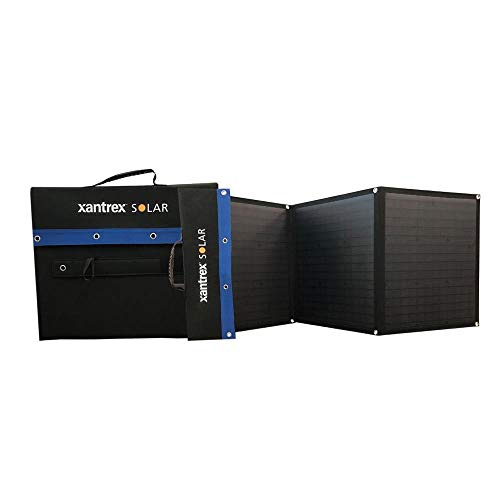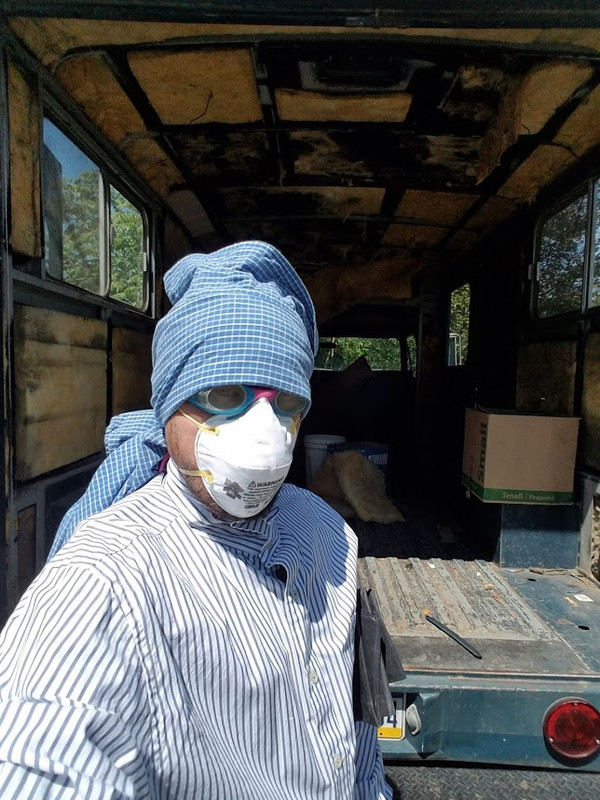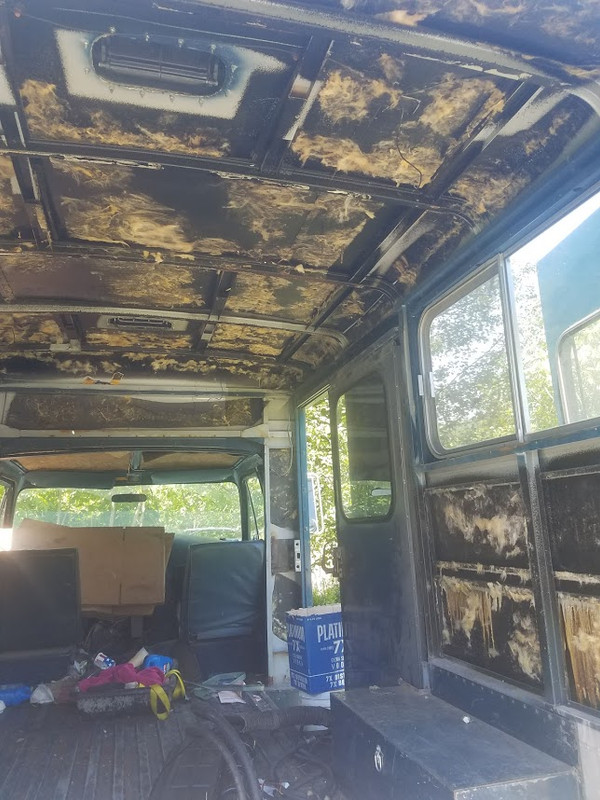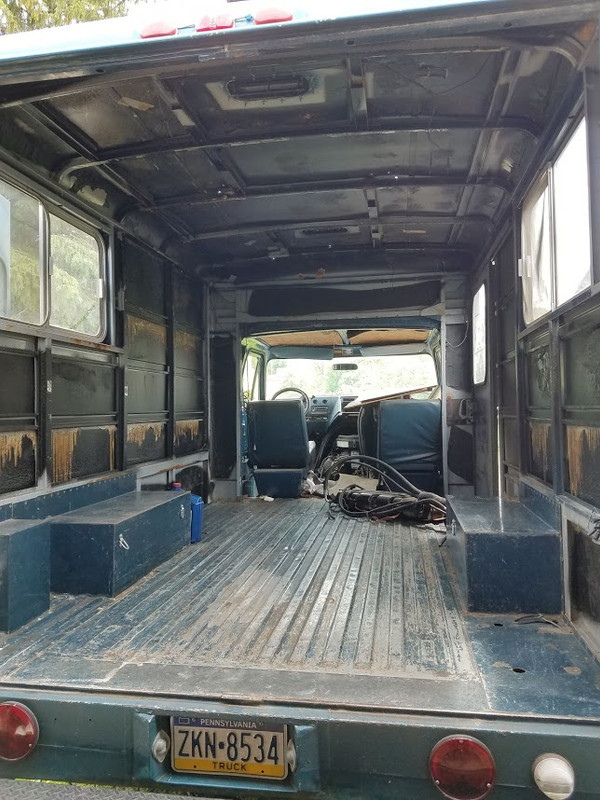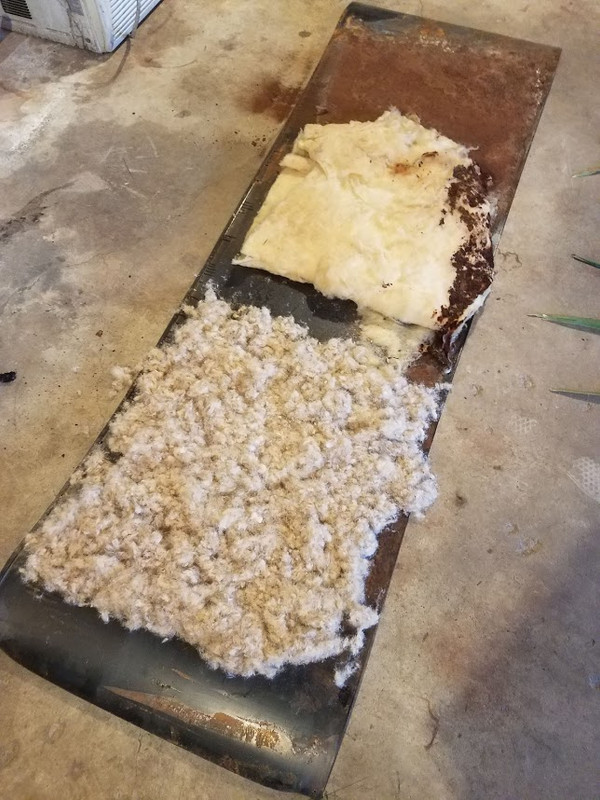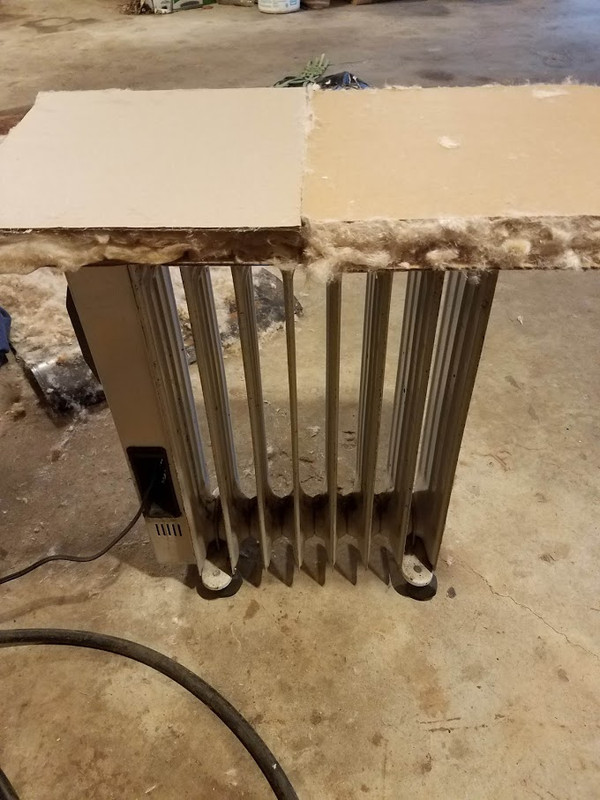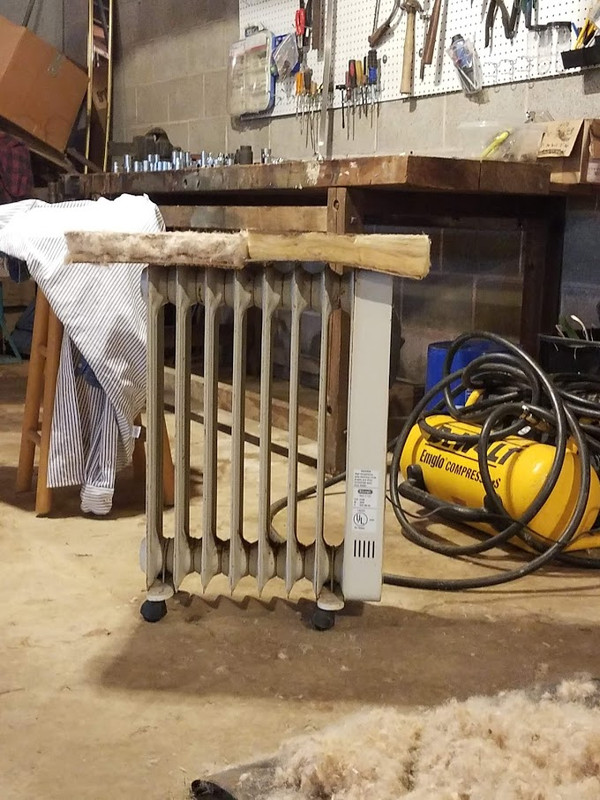KingArthur
Well-known member
- Joined
- Aug 12, 2016
- Messages
- 70
- Reaction score
- 0
This is going to be the main build thread for this big blue (maybe not for long) van.
Van is a military spec G30 with a 6.2 detroit non-turbo diesel motor paired to a 3 speed Hydromatic. It sounds like an old school bus.
I have a small list of various things so far that I'd like to do that are necessary before proceeding further:
- Rear main seal needs to be replaced
- Various gaskests/seals on engine need to be replaced. Oil is seeping out here and there and this must be stopped if possible.
- Paint the lower half of the van with bed liner, and the top half with military surplus paint. Color will be a light desert beige.
- All door gaskets need to be replaced.
- Fiberglass insulation currently installed needs to be removed and replaced with poly board insulation.
- This wild AC unit needs to be either repaired or scuttled. (Link to that thread here: https://vanlivingforum.com/showthread.php?tid=36629)
- Van needs to generally be thoroughly gone over and cleaned. Various holes need to be patched with bondo or fiberglass.
- The extended heater hose that used to run to the auxiliary heater needs to be removed, or an auxiliary heater needs to be installed. (Though I don't know what purpose it would serve.)
- Replace headlights with something brighter and correctly aligned and wired to SHUT OFF WHEN IGNITION OFF!!!
- Seats need to be replaced with something more comfortable.
Now for the fun part...
I have two directions I can go with this build. I only have about two months before I'm going to be leaving the state, and I am undecided whether I want to take thing along with me, or if I want to do a very basic conversion and sell the van and move on. Given the #vanlife culture at the moment, I feel that I could end up making some money on this van by using reclaimed materials and basically giving someone the opportunity to buy a 'blank canvas' that they could essentially just slap some paint on and call their own. So I would install all insulation, flooring, any plumbing and electrical components, and any furniture and sell the van unfinished; at 80%. This would be my second conversion so I do have most of the necessary tools, skills, and experience to pull this off.
The other option is to keep the van for myself. Originally I had big creative plans for this van when I bought it at the end of 2017. Because of various troubles financial and otherwise, no conversion happened and I ended up shelving my ambitions for the project. Once again I'm considering resurrecting this venture and perhaps coming up with something I can call home. My main concern as the van sits right now is its fuel mileage. I'm hoping to address the terrible fuel mileage by putting in much taller differential gears. Thread here: (https://vanlivingforum.com/showthread.php?tid=27696&pid=449168#pid449168). The fuel mileage is hovering around 7 at the moment, and this is utterly unacceptable as far as I'm concerned. I think a minimum of 14 or 15 is going to be my absolute lower limit, so if this is possible, I will most likely end up keeping the van.
I still have some various items hanging around from my last van that ended up going to the great scrap yard in the sky. I still have a nice pure sine wave inverter, a 240w solar panel, and various bits and bobs that would aid a conversion and wouldn't require me to start from scratch. If I do keep the van for myself, I learned very much so what I do and do not like when I lived in my Astro for a year and a half. First, I hate not being able to stand up. Second, I hate having to go somewhere to shower at the end of the day. Third, I hate not being able to take a dump in my van. Fourth, I hate having limited space for cooking.
I bought for the very reason of addressing some of these concerns. Height was the main one. Being that I'm 5' 6", I fit with ample room to spare inside this van; the ceiling being almost exactly 6 feet. It will probably be similar in height once the new insulation, floor and ceiling are added because at this moment it's insulated and the ceiling is covered in this sheet metal you see in the photos. Thought I'm sure some do it to no ill effect, I refuse to live in a small space with fiberglass insulation that gets rattled around every time I drive anywhere.
- The van will need to be fairly heavily insulated being that I would like to be able to survive a winter in the northeast if need be.
- The shower can drain to ground. I don't care about tanks and one can be added later if I change my mind.
- The kitchen will have a large footprint because of my interest in preparing the majority of my food. I have a nice 45(?) quart Engel chest freezer/fridge left over from my Astro that I'll use primarily for refrigeration. So I'm considering building one of the slide-out doohickeys to make it accessible. I learned what a pain in the ass those huge top-opening lids are in these small spaces.
- As for the toilet, I have half a mind to take on an adventurous composting toilet project, but I think planning on the bucket method at this moment would be more reasonable.
- Trojan T-105's are fine batteries, but I may consider dropping the cash for some LiFeP04 batteries or maybe one of these Tesla cells. I'd like the van to have over 1KW of usable power. But again this isn't critical.
I haven't yet organized my thoughts and created a plan to tackle this project. If possible, I'd like to cover the basics first and try to avoid getting stuck in a sort of 'extraneous' project for more time than I have to spare. For instance, when I built out my Astro, I ended up spending an absolutely absurd amount of time and money trying to make a small kitchen counter/sink combo out of fiberglass reinforced poly board after seeing the video of the guy who built all his furniture out of the stuff. It makes an absolutely terrible surface for a countertop for a multitude of reasons, and after 3 or 4 iterations of trying to get that to work I ended up just making the whole thing out of reclaimed Corion. And all just to learn that sinks with flat bottoms don't work in vans at all, when I could have just used a salad bowl with a hole drilled in the bottom and saved myself literally 100 hours of work and at least a few hundred bucks. So, if you catch my drift, THAT'S what I'm trying to avoid with this van.
I don't mind getting involved with ambitious projects, so I think what I'm asking of you guys is just for your advice on setting my priorities. I tend to think WAY beyond my capabilities, and sometimes I just need someone to refocus me onto what is actually going to be useful in the immediate future. Being that I'm self employed, I also need to make sure that this project doesn't take over my entire life and start to rob me of the time I need to keep financially afloat.
Anyway, if you read all that, thank you very much!! Your comments and advice are all appreciated.
<a href="https://postimg.cc/dhnK2bdQ" target="_blank"><img src="https://i.postimg.cc/43RNgZxc/image.jpg" alt="image"/></a><br/><br/>
<a href="https://postimg.cc/G8yN5VBy" target="_blank"><img src="https://i.postimg.cc/fL2NJhDB/image.jpg" alt="image"/></a><br/><br/>
<a href="https://postimg.cc/kVZzwq5C" target="_blank"><img src="https://i.postimg.cc/RFVmS05W/image.jpg" alt="image"/></a><br/><br/>
<a href="https://postimg.cc/TyhBrpfQ" target="_blank"><img src="https://i.postimg.cc/pdBxMF7N/image.jpg" alt="image"/></a><br/><br/>
<a href="https://postimg.cc/XrsTGwSp" target="_blank"><img src="https://i.postimg.cc/yNKBGPLX/image.jpg" alt="image"/></a><br/><br/>
<a href="https://postimg.cc/XrjRYsPR" target="_blank"><img src="https://i.postimg.cc/sg7sK84g/image.jpg" alt="image"/></a><br/><br/>
<a href="https://postimg.cc/BX0WdSBQ" target="_blank"><img src="https://i.postimg.cc/J4y1HtyJ/image.jpg" alt="image"/></a><br/><br/>
<a href="https://postimg.cc/8sWQKJW0" target="_blank"><img src="https://i.postimg.cc/wx4qBDBg/image.jpg" alt="image"/></a><br/><br/>
<a href="https://postimg.cc/H8bqVRdg" target="_blank"><img src="https://i.postimg.cc/wMrgbYr7/image.jpg" alt="image"/></a><br/><br/>
<a href="https://postimg.cc/WqRRpTR8" target="_blank"><img src="https://i.postimg.cc/wMM9Vj0C/image.jpg" alt="image"/></a><br/><br/>
<a href="https://postimg.cc/S2YFpjPj" target="_blank"><img src="https://i.postimg.cc/JnP1Zkc3/image.jpg" alt="image"/></a><br/><br/>
<a href="https://postimg.cc/qt5VY2j9" target="_blank"><img src="https://i.postimg.cc/vBQY4z9H/image.jpg" alt="image"/></a><br/><br/>
<a href="https://postimg.cc/8F5gtZBR" target="_blank"><img src="https://i.postimg.cc/ZqPYYgWM/image.jpg" alt="image"/></a><br/><br/>
<a href="https://postimg.cc/BPfy9pDw" target="_blank"><img src="https://i.postimg.cc/mkPG96rR/image.jpg" alt="image"/></a><br/><br/>
Van is a military spec G30 with a 6.2 detroit non-turbo diesel motor paired to a 3 speed Hydromatic. It sounds like an old school bus.
I have a small list of various things so far that I'd like to do that are necessary before proceeding further:
- Rear main seal needs to be replaced
- Various gaskests/seals on engine need to be replaced. Oil is seeping out here and there and this must be stopped if possible.
- Paint the lower half of the van with bed liner, and the top half with military surplus paint. Color will be a light desert beige.
- All door gaskets need to be replaced.
- Fiberglass insulation currently installed needs to be removed and replaced with poly board insulation.
- This wild AC unit needs to be either repaired or scuttled. (Link to that thread here: https://vanlivingforum.com/showthread.php?tid=36629)
- Van needs to generally be thoroughly gone over and cleaned. Various holes need to be patched with bondo or fiberglass.
- The extended heater hose that used to run to the auxiliary heater needs to be removed, or an auxiliary heater needs to be installed. (Though I don't know what purpose it would serve.)
- Replace headlights with something brighter and correctly aligned and wired to SHUT OFF WHEN IGNITION OFF!!!
- Seats need to be replaced with something more comfortable.
Now for the fun part...
I have two directions I can go with this build. I only have about two months before I'm going to be leaving the state, and I am undecided whether I want to take thing along with me, or if I want to do a very basic conversion and sell the van and move on. Given the #vanlife culture at the moment, I feel that I could end up making some money on this van by using reclaimed materials and basically giving someone the opportunity to buy a 'blank canvas' that they could essentially just slap some paint on and call their own. So I would install all insulation, flooring, any plumbing and electrical components, and any furniture and sell the van unfinished; at 80%. This would be my second conversion so I do have most of the necessary tools, skills, and experience to pull this off.
The other option is to keep the van for myself. Originally I had big creative plans for this van when I bought it at the end of 2017. Because of various troubles financial and otherwise, no conversion happened and I ended up shelving my ambitions for the project. Once again I'm considering resurrecting this venture and perhaps coming up with something I can call home. My main concern as the van sits right now is its fuel mileage. I'm hoping to address the terrible fuel mileage by putting in much taller differential gears. Thread here: (https://vanlivingforum.com/showthread.php?tid=27696&pid=449168#pid449168). The fuel mileage is hovering around 7 at the moment, and this is utterly unacceptable as far as I'm concerned. I think a minimum of 14 or 15 is going to be my absolute lower limit, so if this is possible, I will most likely end up keeping the van.
I still have some various items hanging around from my last van that ended up going to the great scrap yard in the sky. I still have a nice pure sine wave inverter, a 240w solar panel, and various bits and bobs that would aid a conversion and wouldn't require me to start from scratch. If I do keep the van for myself, I learned very much so what I do and do not like when I lived in my Astro for a year and a half. First, I hate not being able to stand up. Second, I hate having to go somewhere to shower at the end of the day. Third, I hate not being able to take a dump in my van. Fourth, I hate having limited space for cooking.
I bought for the very reason of addressing some of these concerns. Height was the main one. Being that I'm 5' 6", I fit with ample room to spare inside this van; the ceiling being almost exactly 6 feet. It will probably be similar in height once the new insulation, floor and ceiling are added because at this moment it's insulated and the ceiling is covered in this sheet metal you see in the photos. Thought I'm sure some do it to no ill effect, I refuse to live in a small space with fiberglass insulation that gets rattled around every time I drive anywhere.
- The van will need to be fairly heavily insulated being that I would like to be able to survive a winter in the northeast if need be.
- The shower can drain to ground. I don't care about tanks and one can be added later if I change my mind.
- The kitchen will have a large footprint because of my interest in preparing the majority of my food. I have a nice 45(?) quart Engel chest freezer/fridge left over from my Astro that I'll use primarily for refrigeration. So I'm considering building one of the slide-out doohickeys to make it accessible. I learned what a pain in the ass those huge top-opening lids are in these small spaces.
- As for the toilet, I have half a mind to take on an adventurous composting toilet project, but I think planning on the bucket method at this moment would be more reasonable.
- Trojan T-105's are fine batteries, but I may consider dropping the cash for some LiFeP04 batteries or maybe one of these Tesla cells. I'd like the van to have over 1KW of usable power. But again this isn't critical.
I haven't yet organized my thoughts and created a plan to tackle this project. If possible, I'd like to cover the basics first and try to avoid getting stuck in a sort of 'extraneous' project for more time than I have to spare. For instance, when I built out my Astro, I ended up spending an absolutely absurd amount of time and money trying to make a small kitchen counter/sink combo out of fiberglass reinforced poly board after seeing the video of the guy who built all his furniture out of the stuff. It makes an absolutely terrible surface for a countertop for a multitude of reasons, and after 3 or 4 iterations of trying to get that to work I ended up just making the whole thing out of reclaimed Corion. And all just to learn that sinks with flat bottoms don't work in vans at all, when I could have just used a salad bowl with a hole drilled in the bottom and saved myself literally 100 hours of work and at least a few hundred bucks. So, if you catch my drift, THAT'S what I'm trying to avoid with this van.
I don't mind getting involved with ambitious projects, so I think what I'm asking of you guys is just for your advice on setting my priorities. I tend to think WAY beyond my capabilities, and sometimes I just need someone to refocus me onto what is actually going to be useful in the immediate future. Being that I'm self employed, I also need to make sure that this project doesn't take over my entire life and start to rob me of the time I need to keep financially afloat.
Anyway, if you read all that, thank you very much!! Your comments and advice are all appreciated.
<a href="https://postimg.cc/dhnK2bdQ" target="_blank"><img src="https://i.postimg.cc/43RNgZxc/image.jpg" alt="image"/></a><br/><br/>
<a href="https://postimg.cc/G8yN5VBy" target="_blank"><img src="https://i.postimg.cc/fL2NJhDB/image.jpg" alt="image"/></a><br/><br/>
<a href="https://postimg.cc/kVZzwq5C" target="_blank"><img src="https://i.postimg.cc/RFVmS05W/image.jpg" alt="image"/></a><br/><br/>
<a href="https://postimg.cc/TyhBrpfQ" target="_blank"><img src="https://i.postimg.cc/pdBxMF7N/image.jpg" alt="image"/></a><br/><br/>
<a href="https://postimg.cc/XrsTGwSp" target="_blank"><img src="https://i.postimg.cc/yNKBGPLX/image.jpg" alt="image"/></a><br/><br/>
<a href="https://postimg.cc/XrjRYsPR" target="_blank"><img src="https://i.postimg.cc/sg7sK84g/image.jpg" alt="image"/></a><br/><br/>
<a href="https://postimg.cc/BX0WdSBQ" target="_blank"><img src="https://i.postimg.cc/J4y1HtyJ/image.jpg" alt="image"/></a><br/><br/>
<a href="https://postimg.cc/8sWQKJW0" target="_blank"><img src="https://i.postimg.cc/wx4qBDBg/image.jpg" alt="image"/></a><br/><br/>
<a href="https://postimg.cc/H8bqVRdg" target="_blank"><img src="https://i.postimg.cc/wMrgbYr7/image.jpg" alt="image"/></a><br/><br/>
<a href="https://postimg.cc/WqRRpTR8" target="_blank"><img src="https://i.postimg.cc/wMM9Vj0C/image.jpg" alt="image"/></a><br/><br/>
<a href="https://postimg.cc/S2YFpjPj" target="_blank"><img src="https://i.postimg.cc/JnP1Zkc3/image.jpg" alt="image"/></a><br/><br/>
<a href="https://postimg.cc/qt5VY2j9" target="_blank"><img src="https://i.postimg.cc/vBQY4z9H/image.jpg" alt="image"/></a><br/><br/>
<a href="https://postimg.cc/8F5gtZBR" target="_blank"><img src="https://i.postimg.cc/ZqPYYgWM/image.jpg" alt="image"/></a><br/><br/>
<a href="https://postimg.cc/BPfy9pDw" target="_blank"><img src="https://i.postimg.cc/mkPG96rR/image.jpg" alt="image"/></a><br/><br/>




